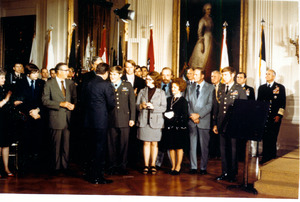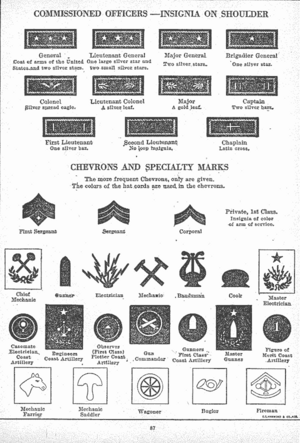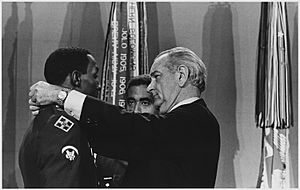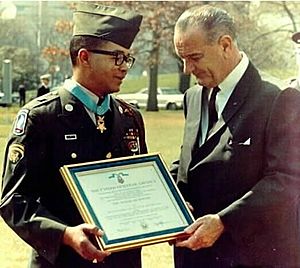Specialist (rank) facts for kids
A Specialist (often called "SPC") is a type of soldier in the U.S. Army. It's one of the first ranks a soldier can earn. A Specialist is higher than a Private First Class but has the same pay level as a Corporal. However, Specialists are not considered junior leaders (called non-commissioned officers or NCOs) like Corporals are.
Contents
Specialists in the U.S. Army
Early Specialist Roles (1902–1942)
The U.S. Army changed its rank system a lot in 1920. Before that, there were many different badges and pay levels. After 1920, they simplified it to seven main ranks and pay levels.
From 1920 to 1942, a "specialist" was a soldier with special skills. They were paid more for their skills but didn't have more authority than other soldiers of the same rank, like a Private First Class. They usually wore the same badge as a Private First Class. Sometimes, commanders allowed them to wear extra stripes to show their skill level.
Technician Ranks (1942–1948)
| Highest Rank | High Rank | Middle Rank | Lower Middle Rank | Low Rank | Lowest Rank | No Badge | ||||
|---|---|---|---|---|---|---|---|---|---|---|
 |
 |
 |
 |
 |
 |
 |
 |
 |
 |
No Insignia |
| First sergeant | Master sergeant | Technical sergeant | Staff sergeant | Technician Third Grade | Sergeant | Technician Fourth Grade | Corporal | Technician Fifth Grade | Private first class | Private |
| 1st Sgt. | M/Sgt. | T/Sgt. | S/Sgt. | T/3. | Sgt. | T/4. | Cpl. | T/5. | Pfc. | Pvt. |
In 1942, the Army created "technician" ranks. These replaced the older specialist roles. Technicians were paid more for their skills. They had some authority but were still outranked by regular non-commissioned officers. To show they were technicians, they wore an embroidered "T" under their rank stripes. These technician ranks were stopped in 1948.
Modern Specialist Ranks (1955–Present)
In 1955, the Army created several new specialist ranks. These were Specialist Third Class (E-4), Specialist Second Class (E-5), Specialist First Class (E-6), and Master Specialist (E-7). Their badges were yellow on a dark blue background. They looked like inverted NCO stripes with an eagle in the middle.
In 1958, more specialist ranks were added, going up to Specialist Nine (E-9). These ranks were meant to reward soldiers with special skills or knowledge. However, specialists were still outranked by all non-commissioned officers (NCOs). This meant they didn't have the same leadership authority as NCOs.
Over time, most of these higher specialist ranks were removed. The Specialist 8 and 9 ranks were removed in 1968. Specialist 7 was removed in 1978, and Specialists 5 and 6 were removed in 1985.
Today, only the lowest specialist rank remains, simply called "Specialist." It's the most common rank in the U.S. Army. Soldiers who are Private First Class are usually promoted to Specialist after two years of service. Sometimes, they can be promoted sooner.

The rank of Corporal (E-4) is now mostly for soldiers who have completed a leadership course or have direct command over other soldiers. Specialists, on the other hand, are recognized for their technical skills.
New recruits who have a four-year college degree often start as a Specialist (E-4). Also, people who become officer candidates often start as Specialists during their basic training. They are then promoted to "officer candidate" when they officially join Officer Candidate School.
The United States Navy also had specialist roles. From 1941 to 1948, they had "Specialist" rates for civilian experts joining the Navy. These specialists had a letter after their title, like Specialist (C) for a "classification interviewer." Their badges had a diamond shape with the specialty letter inside.
After 1948, these roles changed. Some became "Emergency Service Ratings" for Naval Reserve members. Most of these specialist roles were phased out by 1965. The last one, "Information Security Specialist," was removed in 1974.
Images for kids













